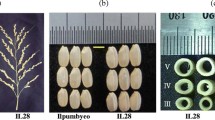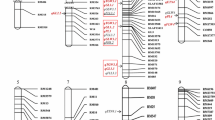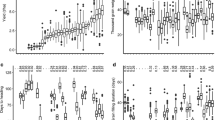Abstract
Quantitative triat loci (QTLs) for yield and related traits in rice were mapped based on RFLP maps from two indica/indica F2 populations, Tesanai 2/CB and Waiyin 2/CB. In Tesanai 2/CB, 14 intervals carrying QTLs for eight traits were detected, including 3 for grain weight per plant (GWT), 2 for number of panicles per plant (NP), 2 for number of grains per panicle (NG), 1 for total number of spikelets per panicle (TNS), 1 for spikelet fertility (SF), 3 for 1000-grain weight (TGWT), 1 for spikelet density (SD), and 1 for number of first branches per main panicle. The 3 QTLs for GWT were located on chromosomes 1, 2, and 4, with 1 in each chromosome. The additive effect of the single locus ranged from 2.0 g to 9.1 g. A major gene (np4) for NP was detected on chromosome 4 within the interval of RG143–RG214, about 4cM for RG143, and this locus explained 26.1% of the observed phenotypic variance for NP. The paternal allele of this locus was responsible for reduced panicles per plant (3 panicles per plant). In another population, Waiyin 2/CB, 12 intervals containing QTLs for six of the above-mentioned traits were detected, including 3 for GWT, 2 for each of NP, TNS, TGWT and SD, 1 for SF. Three QTLs for GWT were located on chromosome 1, 4, and 5, respectively. The additive effect of the single locus for GWT ranged from 6.7 g to 8.8 g, while the dominance effect was 1.7–11.5 g. QTL mapping in two populations with a common male parent is compared and discussed.
Similar content being viewed by others
References
Abenes MLP, Tabien RE, McCouch SR, Ikeda R, Ronald P. Khush GS, Huang N (1994) Orientation and integration of the classical and molecular genetic maps of chromosome 11 in rice. Euphytica 76:81–87
Beavis WD, Grant D, Albertsen M, Fincher R (1991) Quantitative trait loci for plant height in four maize populations and their associations with qualitative genetic loci. Theor Appl Genet 83: 141–145
Burr B, Evola SV, Burr RA, Beekman JS (1988) Gene mapping with recombinant inbreds in maize. Genetics 118:519–526
Causse MA, Fulton TM, Cho YG, Ahn SN, Chunwongse J, Wu K, Xiao J, Yu Z, Ronald PC, Harrington SE, Second G, McCouch SR, Tanksley SD (1994) Saturated molecular map of the rice genome based on an interspecific backcross population. Genetics 138:1251–1274
Champoux MC, Wang G, Sarkarung S, Mackill DJ, O'Toole JC, Huang N, McCouch SR (1995) Locating genes associated with root morphology and drought avoidance in rice via linkage to molecular markers. Theor Appl Genet 90:969–981
Keim P, Diers BW, Olson TC, Shoemaker RC (1990) RFLP mapping in soybean: association between marker loci and variation in quantitative traits. Genetics 126:735–742
Kosambi DD (1994) The estimation of map distances from recombination values. Ann Eugen 12:172–175
Lander ES, Botstein D (1989) Mapping Mendelian factors underlying quantitative traits using RFLP linkage maps. Genetics 121: 185–199
Lander ES, Green P, Abbrahamson J, Barlow A, Daly MJ, Lincoln SE, Newburg L (1987) MAPMAKER: an interactive computer package for constructing primary genetic linkage maps of experimental and natural populations. Genomics 1:174–181
Li ZK, Pinson SRM, Stansel JW, Park WD (1995) Identification of two major genes and quantitative trait loci (QTLs) for heading date and plant height in cultivated rice (Oryza sativa L.). Theor Appl Genet 91:374–381
Lu YJ, Zheng KL (1992) A simple method for extraction of DNA in rice. Chin J Rice Sci 6:47–48
Martin B, Nienhuis J, King Gm Schaefer A (1989) Restriction fragment length polymorphisms associated with water use efficiency in tomato. Science 243:1725–1728
McCouch SR, Kochert G, Yu ZH, Wang ZY, Khush GS, Coffman WR (1988) Molecular mapping of rice chromosomes. Theor Appl Genet 76:815–829
Nienhuis J, Helentjaris T, Slocum M, Rugger B, Schaefer A (1987) Restriction fragment length polymorphism analysis of loci associated with insect resistance in tomato. Crop Sci 27:797–803
Osborn TC, Alexander DC, Fobes JF (1987) Identification of restriction fragment length polymorphisms linked to genes controlling soluble solids content in tomato fruit. Theor Appl Genet 73: 350–356
Paterson AH, Lander ES, Hewitt JD, Peterson S, Lincoln SE, Tanksley SD (1988) Resolution of quantitative traits into Mendelian factors by using a complete RFLP linkage map. Nature 335:721–726
Paterson AH, Deverna JW, Lanini B, Tanksley SD (1990) Fine mapping of quantitative trait loci using selected overlapping recombinant chromosomes in an interspecies cross of tomato. Genetics 124:735–742
Rebai A, Goffinet B, Mangin B (1994) Approximate thresholds of interval mapping tests for QTL detection. Genetics 138:235–244
Saito A, Yano M, Kishimoto N, Nakagahra M, Yoshimura A, Saito K, Kuhara S, Ukai Y, Kawase M, Nagamine T, Yoshimura S, Ideta O, Ohsawa R, Hayano Y, Iwata N, Sugiura M (1991) Linkage map of restriction fragment length polymorphism loci in rice. Jpn J Breed 41:665–670
SAS Institute (1988) SAS users guide: statistics. SAS Institute, Gary, NC.
Stephen EL, Lincoln SE, Lander ES (1990) Constructing genetic maps with MAPMAKER: a tutorial and reference manual. A Whitehead Institute for Biomedical research, Cambridge, USA
Stuber CW, Edwards MD, Wendel JF (1987) Molecular marker-facilitated investigations of quantitative trait loci in maize. II. Factors infuencing yield and its component traits. Crop Sci 27: 639–648
Stuber CW, Stephen EL, Wolff DW, Helentjaris T, Lander ES (1992) Identification of genetic factors contributing to heterosis in a hybrid from two elite maize inbred lines using molecular markers. Genetics 116:823–839
Tanksley SD (1993) Mapping polygenes. Annu Rev Genet 27:205–233
Tanksley SD, Hewitt J (1988) Use of molecular markers in breeding for soluble solids content in tomato — a re-examination. Theor Appl Genet 75:811–823
Vicente MCD de, Tanksley SD (1993) QTL analysis of transgression in an interspecific tomato cross. Genetics 134:585–596
Wang GL, Mackill DJ, Bonman M, McCouch SR, Champoux MC, Nelson RJ (1994) RFLP mapping of genes conferring complete and partial resistance to blast in a durably resistant rice cultivar. Genetics 136:1421–1434
Wu WR, Li WM(1994) A new approach for mapping quantitative trait loci using complete genetic marker linkage maps. Theor Appl Genet 89:535–539
Zheng KL, Shen B, Yu F, Zhao CZ, Qi XF, Xu XM (1990) Restriction fragment length polymorphisms in rice. Chin J Rice Sci 4: 145–149
Author information
Authors and Affiliations
Additional information
Communicated by G. Wenzel
Rights and permissions
About this article
Cite this article
Lin, H.X., Qian, H.R., Zhuang, J.Y. et al. RFLP mapping of QTLs for yield and related characters in rice (Oryza sativa L.). Theoret. Appl. Genetics 92, 920–927 (1996). https://doi.org/10.1007/BF00224031
Received:
Accepted:
Issue Date:
DOI: https://doi.org/10.1007/BF00224031




